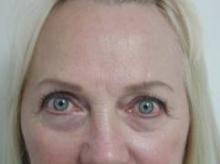DANA POINT, CALIF. – Use of a bipolar radiofrequency probe to the frontalis and corrugator branches of the temporal facial nerve resulted in the diminishment of forehead wrinkles that lasts two to three times longer than treatment with botulinum toxin, according to Dr. James Newman.
At a meeting sponsored by SkinCare Physicians and Northwestern University, Dr. Newman described his early clinical experience with the Serene Solution, a Food and Drug Administration–cleared device created by Serene Medical designed to target nerves and create radiofrequency lesions.
"The purpose of this type of treatment is to take a finite probe, which allows the physician to stimulate and target a very specific nerve on the body," said Dr. Newman, a plastic surgeon in private practice in Palo Alto, Calif. "In this case we’re using a bipolar radiofrequency probe within 1-2 mm of the frontalis and corrugator branches of the temporal facial nerve."
The device, which consists of a control unit and 20-gauge dual-purpose probe, enables one or more small radiofrequency lesions to interrupt the motor nerve signal and reduce muscle activity. "The advantage is that the effect is instant," said Dr. Newman, who is chief medical officer for Serene Medical. "It’s long lasting, produces minimal collateral damage, and allows reconnection along the original path of [the] nerve." The effect can last 6-18 months, depending on the lesion, compared with botulinum that lasts for about 3-6 months.
In split-face studies conducted by Dr. Newman and his associates, 20 patients underwent a single treatment with the Serene Solution to create a radiofrequency lesion on the frontalis and corrugator branches of the temporal facial nerve. Six months post treatment, patient wrinkles remained improved compared with baseline, according to evaluation with Merz Aesthetics Scales. "The muscle response to stimulation currently demonstrates that nerve function is fully restored, when compared to the untreated side," Dr. Newman said. "That told us that the nerve sheath is still intact and that we do not have a complete nerve block." The fact that improvement persists long term in the treated side "may be due to a smaller or less-conditioned frontalis muscle," he said.
Dr. Newman and his associates plan to study the hypothesis that creating three radiofrequency lesions along the frontalis nerve will prolong the period of nerve discontinuity by two to three times. "If we create more than one lesion, perhaps we can prolong relaxation of the frontalis muscle and those wrinkle scores might be improved as well," he said.
Dr. Newman disclosed that he is a stockholder in Serene Medical and that he is a speaker for and has received honoraria from Valeant Pharmaceuticals.



